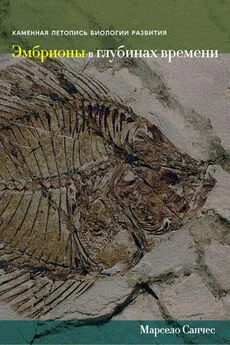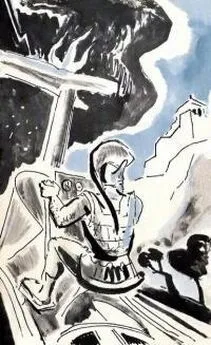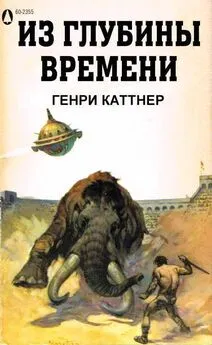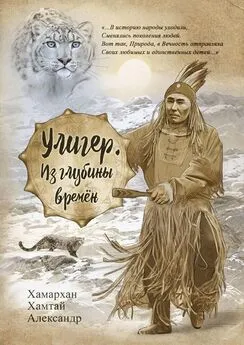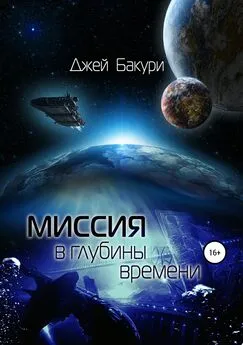Марсело Санчес - Эмбрионы в глубинах времени
- Название:Эмбрионы в глубинах времени
- Автор:
- Жанр:
- Издательство:University of California Press
- Год:2013
- Город:Беркли и Лос-Анджелес, Калифорния
- ISBN:978-0-520-27193-7
- Рейтинг:
- Избранное:Добавить в избранное
-
Отзывы:
-
Ваша оценка:
Марсело Санчес - Эмбрионы в глубинах времени краткое содержание
Эмбрионы в глубинах времени - читать онлайн бесплатно полную версию (весь текст целиком)
Интервал:
Закладка:
Chinsamy-Turan, A., and J. H. Hurum. 2006. Bone microstructure and growth patterns of early mammals. Acta Paleontologica Polonica 51: 325-38.
Chritz, K. L., G. J. Dyke, A. Zazzo, A. M. Lister, N. T. Monaghan, and J. D. Sigwart. 2009. Palaeobiology of an extinct Ice Age mammal: Stable isotope and cementum analysis of giant deer teeth. Palaeogeography, Palaeoclimatology, Palaeoecology 282: 133-44.
Cifelli, R. L., and C. de Muizon. 1998. Tooth eruption and replacement pattern in early marsupials. Compte Rendus de l’Academie des Sciences de Paris, Sciences de la Terre et des Planètes 326: 215-20.
Clark, J. M., M. A. Norell, and L. M. Chiappe. 1999. An oviraptorid skeleton from the late Cretaceous of Ukhaa Tolgod, Mongolia, preserved in an avian-like brooding position over an oviraptorid nest. American Museum Novitates 3265: 1-36.
Cloutier, R. 2010. The fossil record of fish ontogenies: Insights into developmental patterns and processes. Seminars in Cell and Developmental Biology 21: 400–413.Coates, M. I., and M. Ruta. 2007. Skeletal changes in the transition from fins to limbs. In B. K. Hall, ed., Fins to Limbs (pp. 15–38). Chicago: University of Chicago Press.
Cole, K. S., ed. 2010. Reproduction and Sexuality in Marine Fishes: Patterns and Processes. Berkeley: University of California Press.
Colosimo, P. F., K. E. Hosemann, S. Balabhadra, G. Villarreal Jr., J. Grimwood, J. Schmutz, R. M. Myers, D. Schluter, and D. M. Kingsley. 2005. Widespread parallel evolution in sticklebacks by repeated fixation of ectodysplasin alleles. Science 307: 1928-33.
Crompton, A. W., and W. L. Hylander. 1986. Changes in mandibular function following the acquisition of a dentary-squamosal jaw articulation. In N. Hotton III, P. Maclean, J. J. Roth, and E. C. Roth, eds., The Ecology and Biology of Mammal-Like Reptiles (pp. 263-82). Washington, DC: Smithsonian Institution.
Crompton, A. W., and Z.-X. Luo. 1993. Relationships of the Liassic mammals Sinoconodon, Morganucodon oehleri, and Dinnetherium. In F. S. Szalay, M. J. Novacek, and M. C. McKenna, eds., Mammal Phylogeny (pp. 30–44). New York: Springer.
Curry, K. A. 1999. Ontogenetic histology of Apatosaurus (Dinosauria: Sauropoda): New insights on growth rates and longevity. Journal of Vertebrate Paleontology 19: 654-65.
Cuvier, G. 1835-39. Leçons d’anatomie comparée. Vols. 1–6. Reprint, Ann Arbor: University of Michigan Press, 1980.
Darwin, C. R. 1868. The Variation of Animals and Plants under Domestication. London: John Murray. {18} 18 Имеется русское издание — прим. перев.
Dawkins, R. 2009. The Greatest Show on Earth: The Evidence for Evolution. New York: Simon and Schuster. {19} 19 Имеется русское издание — прим. перев.
De Beer, G. 1962. Embryos and Ancestors . 3rd ed. London: Clarendon Press.
Delfino, M., and M. R. Sánchez-Villagra. 2010. A survey of the rock record of reptilian ontogeny. Seminars in Cell and Developmental Biology 21: 432-40.
Dewar, E. 2007. The taxonomic stability of large mammals in the White River Chronofauna masked their changing dietary ecology. Journal of Vertebrate Paleontology 27: 68A.
Dobzhansky, T. 1973. Nothing in biology makes sense except in the light of evolution. American Biology Teacher 35: 125-29.
Domazet-Lošo, T., and D. Tautz. 2010. A phylogenetically based transcriptome age index mirrors ontogenetic divergence patterns. Nature 468: 815-18.
Donoghue, P. C. J. 2005. Saving the stem group — a contradiction in terms. Paleobiology 31: 553–58.
Donoghue, P. C. J., A. Graham, and R. N. Kelsh. 2008. The origin and evolution of the neural crest. Bioessays 30: 530-41.
Donoghue, P. C. J., and M. A. Purnell. 2005. Genome duplication, extinction, and vertebrate evolution. Trends in Ecology and Evolution 20: 312-19.
Duboule, D. 1994. Temporal colinearity and the phylotypic progression: A basis for the stability of a vertebrate Bauplan and the evolution of morphologies through heterochrony. Development (Suppl.) 135-42.
Duboule, D. 2010. The evo-devo comet. EMBO Reports 11: 489.
Dupont, S., B. Lundve, and M. Thorndyke. 2010. Near future ocean acidification increases growth rate of the lecithotrophic larvae and juveniles of the sea star Crossaster papposus. Journal of Experimental Zoology, Part B, Molecular and Developmental Evolution 314: 382-89.
Dupré, J. 2010. The conditions of existence. [Review of John Reiss’s Not by Design.] American Scientist 98: 170.
Durant, W., and A. Durant. 1968. The Lessons of History. New York: Simon and Schuster.
Edgren, R. A. 1960. A seasonal change in bone density in female musk turtles, Sternothaerus odoratus (Latreille). Comparative Biochemistry and Physiology 1: 213-17.
Erickson, G. M., P. J. Makovicky, P. J. Currie, M. A. Norell, S. A. Yerby, and C. A. Brochu. 2004. Gigantism and comparative life-history parameters of tyrannosaurid dinosaurs. Nature 430: 772-75.
Fleagle, J. G. 1999. Primate Adaptation and Evolution . 2nd ed. New York: Academic Press.
Fortey, R. 1998. Life: An Unauthorised Biography . New York: HarperCollins.
Fortey, R. 2000. Trilobites! London: HarperCollins. {20} 20 Имеется русское издание — прим. перев.
Fortey, R. 2004. Earth: An Intimate History. London: Vintage Books.
Fox, D. L., and D. C. Fisher. 2001. Stable isotope ecology of a late Miocene population of Gomphotherium productus (Mammalia, Proboscidea) from Port of Entry Pit, Oklahoma, USA. Palaios 16: 279-93.
Franzen, J. L. 2006. A pregnant mare with preserved placenta from the Middle Eocene maar of Eckfeld, Germany. Palaeontographica (A) 278: 27–35.
Friedman, M. 2008. The evolutionary origin of flatfish asymmetry. Nature 454: 209-12.
Furrer, H. 2003. Der Monte San Giorgio im Südtessin — Vom Berg der Saurier zur Fossil — Lagerstätte internationaler Bedeutung. Neujahrsblatt, Naturforschende Gesellschaft in Zürich 206: 1-64.
Gallis, F. 1999. Why do almost all mammals have seven cervical vertebrae? Developmental constraints, Hox genes and cancer. Journal of Experimental Zoology, Molecular and Developmental Evolution 285: 19–26.
García, V. B., L. O. Lucifora, and R. A. Myers. 2008. The importance of habitat and life history to extinction risk in sharks, skates, rays and chimaeras. Proceedings of the Royal Society of London B 275: 83–89.
Garstang, W. 1922. The theory of recapitulation: A critical restatement of the biogenetic law. Journal of the Linnean Society of London, Zoology 35: 81-101.
Gauthier, J. A., A. G. Kluge, and T. Rowe. 1988. Amniote phylogeny and the importance of fossils. Cladistics 4: 105–209.
Gayon, J. 2000. History of the concept of allometry. American Zoologist 40: 748-58.
Gee, H. 2001. Deep Time: Cladistics, the Revolution in Evolution. London: Fourth Estate.
Giannini, N., A. Goswami, and M. R. Sánchez-Villagra. 2006. Development of integumentary structures in Rousettus amplexicaudatus (Mammalia: Chiroptera: Pteropodidae) during late-embryonic and fetal stages. Journal of Mammalogy 87: 993-1001.
Gilbert, S. F., and D. Epel. 2008. Ecological Developmental Biology . Sunderland, MA: Sinauer Associates.
Gingerich, P. D., M. ul-Haq, W. von Koenigswald, W. J. Sanders, B. H. Smith, and I. S. Zalmout. 2009. New protocetid whale from the Middle Eocene of Pakistan: Birth on land, precocial development, and sexual dimorphism. PLoS ONE 4: e4366.
Göbbel, L., and R. Schultka. 2002. Das wissenschaftliche Programm von Johann Friedrich Meckel d. J. (1781–1833) und seine Bedeutung für die Entwicklung der Wissenschaft vom Leben. Annals of Anatomy 184: 519-22.
Godfrey, L. R., K. E. Samonds, P. C. Wright, and S. J. King. 2005. Schultz’s unruly rule: Dental developmental sequences and schedules in small-bodied, folivorous lemurs. Folia Primatologica 6: 77–99.
Goin, F. J., M. A. Abello, and L. Chornogubsky. 2010. Middle Tertiary marsupials from central Patagonia (early Oligocene of Gran Barranca): Understanding South America’s Grande Coupure. In R. H. Madden, A. A. Carlini, M. G. Vucetich, and R. F. Kay, eds., The Paleontology of Gran Barranca: Evolution and Environmental Change through the Middle Cenozoic of Patagonia (pp. 36–47). Cambridge: Cambridge University Press.
Goldschmidt, R. 1933. Some aspects of evolution. Science 15: 539-47.
Gompel, N., and B. Prud’homme. 2009. The causes of repeated genetic evolution. Developmental Biology 332: 36–47.
Goodrich, E. S. 1913. Metameric segmentation and homology. Quarterly Journal of Microscopical Science 59: 227-48.
Gostling, N. J., P. C. J. Donoghue, and S. Bengtson. 2007. The earliest fossil embryos begin to mature. Evolution and Development 9: 206-7.
Gostling, N. J., C. W. Thomas, J. M. Greenwood, X. Dong, S. Bengtson, E. C. Raff, R. A. Raff, B. A. Degnan, M. Stampanoni, and P. C. J. Donoghue. 2008. Deciphering the fossil record of early bilaterian development in the light of experimental taphonomy. Evolution and Development 10: 339-49.
Goswami, A. 2006. Cranial modularity shifts during mammalian evolution. American Naturalist 168: 270-80.
Goswami, A., N. Milne, and S. Wroe. 2011. Biting through constraints: Cranial morphology, disparity, and convergence across living and fossil carnivorous mammals. Proceedings of the Royal Society of London B, Biological Sciences , 278: 1831-39.
Gould, S. J. 1974. The origin and function of “bizarre” structures: Antler size and skull size in the “Irish elk,” Megaloceros giganteus. Evolution 28: 191–220.
Gould, S. J. 1977. Ontogeny and Phylogeny. Cambridge, MA: Belknap Press.
Gould, S. J. 1988. Time’s Arrow Time’s Cycle. Cambridge, MA: Harvard University Press.
Gould, S. J., and N. Eldredge. 1993. Punctuated equilibrium comes of age. Nature 366: 223-27.
Grande, L., and E. J. Hilton. 2006. An exquisitely preserved skeleton representing a primitive sturgeon from the upper Cretaceous Judith River formation of Montana. Journal of Palaeontology 80: 1-39.
Gray, S. W. 1946. Relative growth in a phylogenetic series and in ontogenetic series of one of its members. American Journal of Science 244: 792–807.
Gregory, T. R. 2005. Genome size evolution in animals. In T. R. Gregory, ed., The Evolution of the Genome (pp. 4-71). Boston: Elsevier Academic Press.
Guthrie, R. D. 2003. Rapid body size decline in Alaskan Pleistocene horses before extinction. Nature 426: 169-71.
Haeckel, E. 1866. Generelle Morphologie der Organismen: allgemeine Grundzüge der organischen Formen-Wissenschaft, mechanisch begründet durch die von C. Darwin reformirte Descendenz-Theorie. Berlin: Reimer.
Haeckel, E. 1874. Anthropogenie oder Entwicklungsgeschichte des Menschen . Leipzig: Engelmann.
Hafner, J. C., and M. S. Hafner. 1988. Heterochrony in rodents. In M. L. McKinney, ed., Heterochrony in Evolution: A Multidisciplinary Approach (pp. 217-35). New York: Plenum Press.
Hall B. K. 1999. Evolutionary Developmental Biology . 2nd ed. New York: Springer.
Читать дальшеИнтервал:
Закладка:
